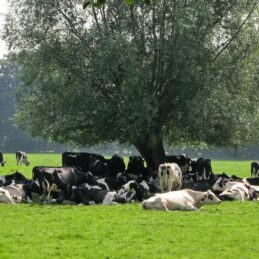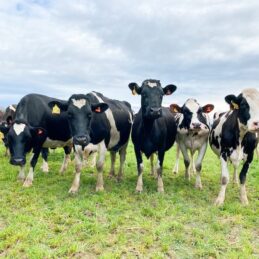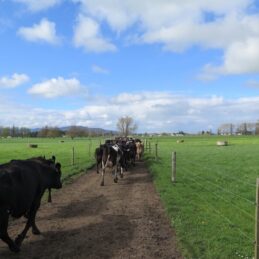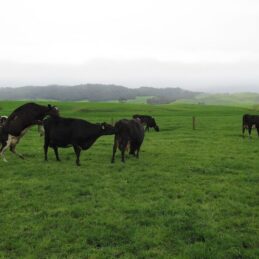Rearing calves in the autumn has a different set of environmental challenges than calves traditionally reared in springtime in New Zealand. Weather conditions tend to be warmer and drier in autumn so the challenges of maintaining hygiene in calf sheds is easier with less moisture in the bedding material.
Additionally, the nutritional energy demands of the calf are less due to the warmer weather, so calves tend to grow quicker because of the more favourable conditions. Also, due to the warmer weather, calves are generally released from the pens onto pasture at an earlier age which, in autumn, often means calves are entering paddocks on a declining grass growth rate which can have its own unique challenges in meeting the calves’ daily nutrient requirement.

Once the calf is born, the most important step is to get good quality “Gold” colostrum, with high IgG levels, into the calf (see https://www.nutritech.co.nz/getting-ourfuture-off-to-a-great-start/).
Since cows calving in autumn are often exposed to heat stress, there is research1 that suggests that this impacts the quality of the colostrum she produces which impacts the health and growth of the calf. The use of a refractometer can be used to ensure good “Gold” quality colostrum is fed in the first 24 hours. In addition, ensure colostrum is well stored by using a preservative like Colostrum Keeper (https://www.nutritech.co.nz/product/nutricare-colostrum-keeper/).
As with all calf rearing, the liquid milk phase is critical to ensure calves get an adequate intake of nutrients into the abomasum and small intestine for absorption and allow the calf to reach target bodyweights. If feeding whole milk during this phase, it’s important to supplement the milk with vitamins and trace minerals as these often do not meet the requirements for a growing calf.
Adding a milk additive, like DanCalf® Gold (https://www.nutritech.co.nz/product/dancalf-gold), provides all the essential vitamins and trace minerals together with probiotics and pre-biotics to support digestive health.
In addition, it contains a coccidiostat (Bovatec®) to protect against coccidiosis – an ever present opportunistic protozoal disease that can undo all the hard work in rearing a good quality calf for lifetime performance. If feeding a calf milk replacer (CMR), ensure that a reliable consistent brand is used that contains added vitamins and trace minerals.
Age and Weight
Age and weight of weaning are critical to any calf rearing system and autumn calving provides an easier pathway to achieve weaning weight for age versus spring calving, due to the favourable weather conditions. However, autumn born calves are weaned from the milk phase to the solid phase, autumn weather provides some challenges as calves are shifted to pasture that is normally of declining quality – both in protein and energy. It is, therefore, important to maintain a good source of calf feed that is high in good quality protein and also of good quality energy derived from grains.
These grains provide the starch for the bacteria in the rumen to produce volatile fatty acids (VFA’s) – a critical source of energy for the young calf. These VFA’s also help develop the finger like projections in the rumen (rumen papillae). It’s also important for the calf feed to be suitably balanced with macro minerals (calcium, phosphorous) for skeletal and frame growth together with trace minerals to support good growth.
A trial conducted in the Manawatu2, showed that the use of a live yeast like Levucell®SC, can prevent the post weaning dip often seen when transitioning from milk phase to the solid feeding phase. Levucell®SC improves nutrient digestibility of the pasture and calf feed in the rumen by providing a smooth transition from the liquid to the solid phase.
As always, ad lib access to fresh, clean water is a must for any calf rearing system – it is often the forgotten nutrient!
Contact your local Nutritech Area Manager for more information
- Tao S, Monteiro AP, Thompson IM, Hayen MJ, Dahl GE.(2012). Effect of late gestation maternal heat stress on growth and immune function of dairy calves. Journal of Dairy Science. 95:7128–36.
Laporta J, Fabris TF, Skibiel AL, Powell JL, Hayen MJ, Horvath K, et al. (2017) In utero exposure to heat stress during late gestation has prolonged effects on the activity patterns and growth of dairy calves. J Dairy Sci. 100:2976–84. - A. Turney1, A. Clay and L. Waldron. The effect of feeding Levucell SC® rumen specific live yeast on feed intake and weight gain performance of calves during weaning. Journal of Applied Animal Nutrition, Vol. 5; e9;
https://www.nutritech.co.nz/wp-content/uploads/2024/02/LSC_TS_Calf_ WEANING_NEWZEALAND2015_ENG_1217.pdfhttps://www.nutritech.co.nz/wp-content/uploads/2024/02/JAAN_calf_ Levucell_paper-FINAL.pdf





